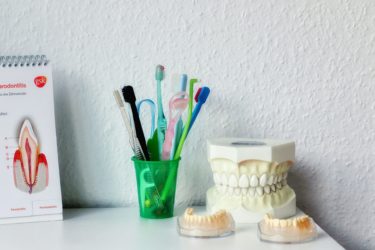We all expect dentists and other healthcare professionals to practice in an evidence-based way and their patients’ best interests. Despite a lack of evidence for many interventions and several issues in applying evidence to clinical practice, this is mainly true. However, some dentists, willingly or not, actively promote and sell pseudoscientific and evidence-free treatment to their patients. While some of these interventions are relatively harm-free, others may be actively detrimental to your oral and general health.
Spotting these rogue practitioners and dubious remedies can be difficult for the layperson patient. So here’s a handy walkthrough of some of the more common red flags to look out for.
Holistic Dentistry
Let’s start with the basics. A ‘holistic dentist’ (sometimes also advertised as a ‘biological dentist’) often eschews accepted practice. They’ll almost certainly avoid placing amalgam fillings (which in itself is no bad thing), often advise against fluoride toothpaste, and may even try to steer you away from having root canal treatment. In some cases, they’ll even offer further ‘alternative’ services, such as a detox regime involving intravenous vitamin C.
This definition of holistic is very different to mine. I’d consider holistic healthcare to be bearing in mind our patients’ wants and needs during consultations and treatment – to treat them as a person and not just a set of teeth. This may be as complicated as understanding complex social, psychological or cultural needs that affect dental treatment, or simply remembering that their children have just left for university and asking how they’re getting on. Understanding how disease in the mouth can correlate with general ill-health is also acting holistically. This is to be encouraged. Scaremongering over fluoride, less so.
Ozone Therapy
Ozone is a powerful oxidising agent often used as an antimicrobial. In dentistry, it is either used in gaseous form, through the application of ozonated oils or even as an intravenous infusion. The idea is that ozone’s oxidising power will kill off any remaining bacteria wherever it’s applied (although I’m not quite sure how that’s supposed to work for IV O3). The research behind ozone therapy in dentistry isn’t exactly great, and NICE (that’s the National Institute for Health and Care Excellence, the body that recommends what treatment should be available on the NHS, among other things) have decreed that it shouldn’t be used for the treatment of decay. Nevertheless, it’s still commonplace to see practitioners offer some form of ozone therapy to patients, once again often as part of a regime of treatments, each with minimal evidence to back them up.
Mercury Detox
Dental amalgam has been popular for over 200 years. It’s relatively cheap, easy to use and considered safe by the majority of the dental profession. Patients requesting removal of their old amalgam (silver) fillings are becoming more and more commonplace, usually for aesthetic reasons. But there’s a subset of people (dentists and patients) out there who are convinced that their fillings are poisoning them. Dental amalgam is an alloy consisting of around 50% mercury along with other metals, including copper, tin and zinc. Mercury-containing dental materials are slowly being reduced and phased out. Worldwide, the Minimata Treaty aims to reduce environmental pollution from mercury. Dental amalgams have traditionally contributed significantly to this pollution, often during cremation, and it’s this environmental concern that’s pushing the move away from the use of silver fillings.
That’s not to say that the health of patients isn’t a concern. In the UK, we’re already advised against placing silver fillings in under 15s, and pregnant patients. We know that mercury is released into the atmosphere whenever silver fillings are placed and removed, but as a general rule, the people most at risk are your dentist and their nurse. But that risk is generally small and mitigated by several measures, including the high-volume suction and even the use of rubber dam.

Most of us are pretty happy to remove old amalgams without a second thought. But there are some who feel that extra protocols are needed—specifically the SMART protocol for amalgam removal. Here, dentist, nurse and patient covered in enhanced PPE, rubber dam use is mandated, and an industrial extractor is used to remove any mercury vapour produced during the procedure. Patients are often given a cocktail of supplements after the procedure to chelate any mercury that may have entered the system.
Most dentists have traditionally scoffed at the SMART protocol, but in the time of COVID, the enhanced PPE and extraction units are now commonplace in surgery. These dentists certainly had a head start when it came to being pandemic ready. But a stopped clock is right twice a day after all.
Homeopathy
Finally, for now, our old friend homeopathy. If you’re reading this, it’s likely that you’re already aware of the ins and outs of homeopathic ‘medicine’, but in case you aren’t… Homeopathy is a mainstay of pseudoscientific alternative medical practice that uses ultra-dilute preparations of almost anything you can think of to treat many ailments. Often the remedies are so diluted that there isn’t even a single molecule of the final product’s original material.
Homeopathy in dentistry is usually limited to complementary therapy, which is to be used alongside ‘traditional’ dentistry rather than as a replacement for it. Even then, the recommendations are often somewhat questionable. Despite this, the use of homeopathy occasionally pops up in articles for well-respected journals.
The British Homeopathic Dental Association is a charity with the specific aims of promoting homeopathy and other complementary therapies within dentistry. Needless to say, homeopathy has no place in a modern healthcare profession, let alone to have a charitable organisation promoting its use. Here is yet another case of the Charity Commission overlooking pseudoscience, to the detriment of patients.
So there’s a quick run-through of a few of the most common things you’ll see in the world of ‘alternative dentistry.’ Look out for more of the same in the future.



